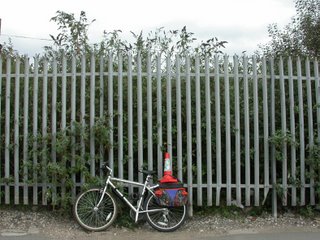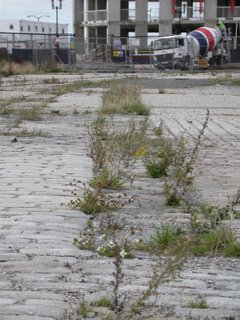




Tuesday 26/09/06
I should point out that I am not a sporty miss. The last time I rode a bike was a staggering 18 years ago. (Because of this I thought it wise to buy cycling trousers with a padded bum. Thank god I did!) And I don’t live a carbon neutral life. I have a big red van, and am pretty reliant upon it. My aim for this project is to keep my carbon footprint to a realistic minimum which basically means that I drive to my designated area, park up, and cycle from there. In my current state of fitness, this is the best I can do.
First task of the day was to set up my stall in The Outhouse, Woolton, L25. Having deposited drawing stuff, Perspex boxes and a plastic picket fence, I set off on my bike, pooch in tow.
Pepe the poodle isn’t really part of the project, more of a hanger on – quite literally. Based in Manchester, I have opted to stay with friends here in the ‘pool for 3 nights a week leaving me with a doggy predicament. Can’t leave him at home on his own, can’t leave him in a strange place, so have purchased a bijous bicycle appendage – a kiddie trailer – perfect for the dog, sketch books, and flask of coffee.
Pepe safely strapped in, and with the all-important Independents ‘open’ Cone fixed onto the pannier rack I begin to peddle the streets of Woolton accompanied by the musical whinnying of a dog that is not 100% convinced of the situation.
Woolton is not really the best part of Liverpool to be seeking out derelict or wastelands sites. In fact it’s difficult to believe you are in the city. I don’t know much about the history of Woolton, but making assumptions based on the visual clues - the hand hewed red sandstone walls and buildings - my guess is that Woolton was a village on the outskirts of the city, and over time has been engulfed by sprawl and suburbia.
It was 2.00pm before I found a Brownfield site, small and tucked away behind the shops.
Using my evaluation sheet, which I shall post at a later date – this small site scored a 15.5, making it a “blue” site
• 80% concrete floor covering
• Early stages of succession, with young Budlea, Mugwort, Oxford Ragwort, and Dandelions to name a few, but no nitrogen fixing plants evident
• No trees or shrubs
• Demolition debris and litter
• Accessible
• A near-by community
The evaluation has 5 categories for value of experiencing ‘nature’
• White 9 to 15
• Blue 15.5 to 22
• Yellow 22.5 to 30
• Red 30.5 to 40
• Green 40.5 - 45
Tagged and recorded I continued cycling through the streets of Woolton, people pointing, smiling, and children screaming out “look at the puppy dog”
2 hours later I came across a second site – pushing boundaries a little bit because this site is at the very end of Out Lane, and on the Knowsley boarder. Because the site can be and is accessed by people living in Woolton, I evaluated the site and awarded it a ‘yellow’.
From the end of Out Lane back to The Outhouse is uphill all the way – and with trailer in tow, this is not an easy ride – my leg muscles burnt and by the time I reached my base they were like jelly. Pepe by this time had become accustomed to his mode of transport and was fast asleep.
The Outhouse is the studio come exhibition venue, the place where I collate and display my findings. It is a glass structure set back from Menlove Avenue in a wooded pedestrian green way that links several tower blocks.
It was not long before a curious passer by stopped to ask what I was up to.
Robert, who lives in one of the flats, was intrigued by the project. During our conversation I asked him about the monolithic block of red rock with desirable recently built detached properties at its base, and found out that it was Woolton Quarry; the stone for Liverpool Cathedral came from there. He told me that Woolton is not the place to find derelict sites, “Woolton is one of the best and most beautiful districts in Liverpool, but Liverpool is full of derelict places.” He said he would gladly take me to sites all over the city, accompany me on his bike if it were not for the fact that he’s leaving for Saudi Arabia tomorrow on a 2-year contract.
My next encounter was with Carol. Carol walks past The Outhouse when she’s out with her dogs, Picasso and Monet. She collects the golf balls she finds – strays form the golf course the other side of the tree-lined dual carriageway, Menlove Avenue, which also has a tree lined central reservation… some golf swings! She handed me 2 balls, which I put into one of my Perspex boxes. Carol and I have struck a deal, all the balls she collects over the duration of the project will go in one of the Perspex boxes.
At the end of my first day, having clocked up 10 miles, I have concluded a couple of things:
1. Woolton is a biodiverse district of Liverpool. It has a wealth of green spaces, parks, a golf course, wooded areas, allotments, and gardens. If Brownfield sites are of value to wildlife in a city - green stepping stones amongst the built environment - then Woolton wont really benefit from such places as it already has a wealth of wildlife heavens.
2. It is time to move on from Woolton and head towards the less affluent areas – along the dock road
The challenge of this project is not the cycling and the evaluation of the sites, but the evaluation of public perception. What do people relay think about Brownfield sites? And is it possible to appreciate these sites for their nature aesthetic value? What I see is the wonderment of nature – what do others see?
This is a very public project. Making a spectacle of myself and evaluating derelict sites for their value for experiencing nature only really makes sense if people know what I am doing and have the opportunity to discuss urban Brownfield sites.


























